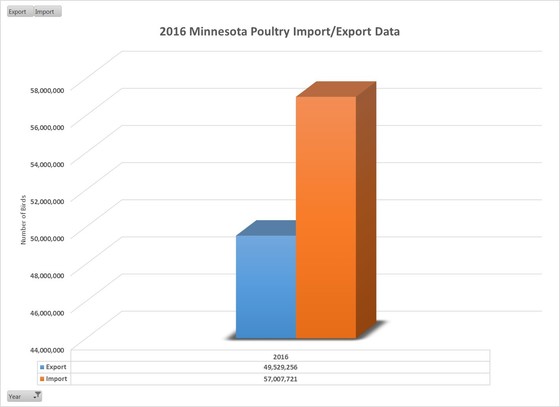|
For Immediate Release: Wednesday, May 3, 2017
Animal disease traceability program releases annual movement numbers
Millions of livestock and poultry tallied in 2016
St. Paul, Minn. — Each year, the Minnesota Board of
Animal Health records the movements of millions of animals into and out of the
state. Tracking these animals and their movements is a vital part of the
Board’s work to monitor and respond to animal disease events. In 2016 there
were 5.7 million domestic animals imported into Minnesota and 2.1 million exported,
excluding domestic poultry, which was 49.5 million exports and 57 million
imports.
“The flow of domestic animal movements within the state and
across Minnesota’s borders helps fuel our agricultural economy, which
underscores the necessity to maintain a database of where they’ve been and when,”
said Dr. Stacey Schwabenlander, senior veterinarian in charge of the Board’s
traceability program. “If a disease of concern is discovered in a group of
animals in Minnesota, we need to know where they came from and what other animals
they had contact with so we can appropriately respond and contain the disease.”
In 2014, the Board moved to a new electronic database to sort,
store and easily search animal movement data. This database also maintains
health records for some species, which increases the number of records that can
be used for traceability. The Board works closely with the United States
Department of Agriculture and other states to further enhance our country’s
Animal Disease Traceability program.
The Board’s goal is to continue increasing our ability to
electronically gather, maintain and utilize these records to support a response
to a disease event. New technology
includes exploring apps, using smart technologies in the field, and encouraging
the use of electronic forms over paper. Domestic animals cannot be easily
tracked unless they’re officially identified. Free official ear tags are
available from the Board for use by livestock owners and veterinarians.
If you’d
like to learn about how the Board of Animal Health tracks different species and
see the different forms of official identification, please visit www.bah.state.mn.us.
 
Contact Information:
Michael Crusan, Communications Director
Minnesota Board of Animal Health
651-201-6815
michael.crusan@state.mn.us
|